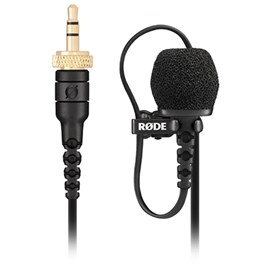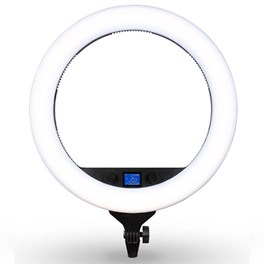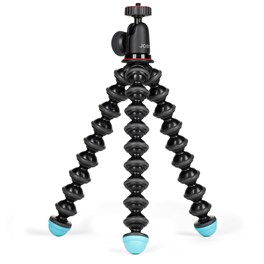
If you’re looking to up your TikTok game, getting the best equipment for TikTok is the way to do it. While the first step is to pick up the best camera for TikTok, your next step is to pick out your essential accessories. Lighting, camera supports, microphones — all of it is going to make a real, tangible difference to the quality of your TikTok content.
We’ve picked out a range of accessories that will improve the visual and audio quality of your TikToks, with options for both smartphone users and those who have upgraded to a fully fledged camera system. We’ve aimed to keep the budget low, as many TikTok shooters don’t have a lot to spend, and have picked accessories that are easy to use and will make a real difference.
So, let’s get into it. Oh, and don’t forget to follow us on TikTok, of course…
Best smartphone mic for TikTok:
Pros:
- Excellent audio quality
- Slim, unobtrusive design
- Easy to set up and clip on
Cons:
- Omnidirectional design may pick up background noise
We’ve said it before across our buying guides, tutorials, and videos, but we’ll say it again — high-quality audio is absolutely critical if you’re taking your content creation seriously. Even if you’re just recording TikToks on your smartphone, a good microphone is essential if you want your content to feel (and sound) professional.
A lavalier mic is the ideal choice if you want your audio setup to be heard and not seen. Designed to be clipped unobtrusively onto clothing, lav mics are commonly used in television, theatre and public speaking events. The Rode Lavalier II is a textbook example and is an ideal way to improve the audio in your TikToks.
The mic has a low-profile design that’s easy to camouflage in your clothing (though you may want a piece of black tape to put over that white ‘Rode’ logo on the clip). The audio quality is excellent, with plenty of range that delivers a full-sounding vocal response. It works well with wireless systems like the Rode Wireless GO II (more on which in a later section).
Also, the kit includes both a pop filter and a windshield for controlling noise. This is something to watch for with lav mics, as they use an omnidirectional polar pattern that records sound from all directions, unlike shotgun mics, which are highly directional.
Best camera mic for TikTok:
Pros:
- Highly effective directional recording
- Long-lasting battery and clever auto power-saving
- Safety channel setting
Cons:
- Cheaper options available
The Rode VideoMic Pro+ is one of the best on-camera shotgun mics ever made. The original VideoMic Pro was pretty popular, but this updated version takes everything that users liked about it – and tweaks the things they didn’t – to make for an absolutely superb camera microphone.
The Rode VideoMic Pro+ uses a super-cardioid directional pattern to pick up the sound from where you’re pointing it, and does an amazing job of cutting out everything else. Also, if you’re worried about clipping (distorting) from an unexpected loud sound, there’s the option to record a separate safety channel with gain at 10dB lower. This means if the primary channel is blown out by a loud noise, you have a clean backup.
With a long-lasting battery and intelligent power-saving feature that powers the mic down when the camera is turned off, the Rode VideoMic Pro+ will keep on recording as long as you need it to. In a pinch, you can also plug in a continuous power source via USB, or even swap out the rechargeable Li-Ion battery for a couple of generic AAs.
If the Rode VideoMic Pro+ is beyond your budget, you could alternatively consider the Sennheiser MKE 400. Its compact build means it fits well on top of even smaller vlogging cameras, and its low-cut filter can be turned on if you need to eliminate low-frequency rumbles or wind noise. There’s also an integrated windscreen, and a built-in headphone jack so you can monitor as you record. The MKE400 does have a gain sensitivity switch, though it only offers three settings (-20dB, 0dB and +20dB).
Best wireless mic for TikTok:
Pros:
- Beautifully well built
- Excellent sound quality and noise suppression
Cons:
- Some settings can only be adjusted on computer
Rode’s Wireless GO was popular in the content creation world, but the GO II would prove to be the real game-changer. The most significant change was the adding of an extra transmitter and the ability to record two audio channels simultaneously, making the setup much more versatile. DJI would go on to be, ahem, inspired by this design in the creation of its DJI Mic, and it’s not hard to see why. With superb noise control and powerful Series IV 2.4GHz digital transmission with 128-bit encryption, the Rode Wireless GO II is the kind of mic you can rely on.
Granted, it doesn’t have the nifty all-in-one charging case of the DJI Mic (see below for more on that), but the Li-Ion batteries in the Rode units will last a good long while, and can actually be powered and charged through your phone if necessary.
Best ring light for TikTok:
Pros:
- Simple and lightweight
- 3200-7500K colour temperature control
- Can run off mains or batteries
Cons:
- Less raw power than other lights
- Optimised for smartphones rather than cameras
A bit of extra light can be just the thing to give your TikToks that professional polish. Whether you want to illuminate yourself, or want a portable light source that can be shone on multiple different subjects, a video light is a sensible and inexpensive thing to add to your kit.
Ring lights are popular on TikTok for good reason. They provide an inexpensive but reasonably customisable source of light that’s ideal for delivering pieces straight to camera. With lights like the Kenro Smart Lite 19 Inch RGB Ring Light, it’s obvious at a glance the extent to which they are oriented towards TikTok users – the fact that it comes pre-packaged with a smartphone clamp in the middle of the ring is probably the clearest indication.
With fine-tuning brightness control, a broad colour temperature range and a palette of customised colours, the Kenro Smart Lite makes it easy to introduce dramatic lighting effects into your videos. The fact that you can run it off mains power or batteries also makes it quite versatile, allowing you to set up and shoot just about anywhere. It comes with its own carry case, and is quite portable with a weight of just 960g.
Best LED panel for TikTok:
Pros:
- Very affordable
- Flexible mounting options
- Very light and portable
Cons:
- Fairly basic feature-set
- Narrower colour range than other lights
Godox has carved out something of a reputation for producing the cheapest LED panels that are actually worth buying. The Godox LEDP120 Flat LED Video Light is very inexpensive, and still delivers the basics of what you need from a video light: smooth, even, flicker-free illumination. The light consists of 116 LEDs, and brightness can be adjusted from 10% to 100%. The colour temperature range runs from 3300K to 5600K — not as broad a range as the Kenro ring light, but still offering a decent gamut.
Naturally, the Godox LEDP120 isn’t going to give you the kind of raw brightness and fine control you’d get from a much more expensive video light, but that’s par for the course. As long as you’re aware of its limitations, it could be just the thing you need to give your TikToks a little lift.
Best tripod for TikTok:
Pros:
- Flexible legs allow for creative positioning
- Very compact and portable
Cons:
- Lacks the height of a traditional tripod
For TikTok, a small and portable tripod may well serve you better than a full-size one. The OBY GorillaPod Custom 1K Kit is the ideal choice, designed to support small mirrorless cameras or compacts, and can easily be adapted to take a phone with the addition of the JOBY GripTight PRO 2 mount.
As is standard with Joby’s GorillaPods, the legs are flexible, meaning they can be positioned however you please and even wrapped around protruding objects like poles or branches if you want a really unusual perspective. However, the tripod also works brilliantly as a simple support, and it’s lightweight enough that you can easily bring it everywhere with you if you’re travelling. It supports devices up to 1kg in weight, which obviously includes all phones, and should also be fine for small camera setups.
Best gimbal stabiliser for TikTok:
Pros:
- Hugely effective stabilisation for moving footage
- Magnetic phone clamp with quick release
- Comes with Grip Tripod accessory for free-standing
Cons:
- Smartphones only
If you tend to capture dynamic, handheld footage out in the world rather than shooting all your TikToks at home, then a stabilising gimbal like the DJI Osmo Mobile 6 is an essential accessory. With powerful stabilising technology working around a 3-axis optical system, the Osmo Mobile 6 keeps your footage silky smooth, even when you’re running and gunning. For pieces to camera that you don’t want locked off on a tripod, it’s a superb option.
Bear in mind that as the name implies, the DJI Osmo Mobile 6 is designed expressly for use with smartphones. If you want an inexpensive stabilising gimbal for a mirrorless or compact camera, the Zhiyun Crane M2S is a good choice. It weighs just 549g but can even effectively stabilise full-frame mirrorless cameras and lenses.

How to choose the best travel tripod
If you’re creating content for TikTok (or any short-form platform), you’ll know that good gear can make a world of difference. You don’t need a full studio setup or a massive budget; it’s about choosing the right tools that make your videos look and sound professional, without slowing you down.
As you'll have seen in this guide, we’ve broken down our recommendations into simple categories, covering everything from sound and lighting to tripods and lenses. The idea isn’t that you’ll need everything listed here, far from it. Instead, think of this guide as a way to identify what might take your TikToks from decent to next-level.
Smartphone microphones
If you’re filming on your phone, a dedicated mic is one of the easiest and most affordable upgrades you can make. Poor audio instantly makes a video feel low quality, no matter how good the visuals are. A small plug-in or clip-on microphone can add clarity and richness to your voice, helping your videos sound as polished as they look.
Camera microphones
For those filming with mirrorless or DSLR cameras, a proper on-camera microphone can make all the difference. These mics capture cleaner, more directional audio, cutting out background noise and giving your videos that professional edge.
Wireless audio systems
If you want freedom to move around, a wireless mic system is the way to go. These kits pair transmitters and receivers, allowing you to record crisp audio even when you’re several metres from the camera. They’re ideal for vlogs, interviews or any situation where you want flexibility without sacrificing sound quality.
Video lights
Lighting is everything. Even a simple LED panel or ring light can completely transform the look of your video. A touch of soft, even lighting can eliminate harsh shadows and make your content instantly more watchable. It’s a small change that makes a huge impact.
Tripods
For sit-down chats, product demos or any steady shot, a solid tripod is essential. Whether you prefer a compact tabletop model or a full-sized stand, it’ll help you keep things stable and consistent, especially when filming solo.
Camera lenses
If you’re shooting with an interchangeable-lens camera, the right lens can change everything. From crisp wide-angles for creative framing to fast primes that give you smooth background blur, we’ve included a few options that’ll lift the overall look of your videos.
FAQs
What are the must-have accessories for TikTok?
The must-have accessories for TikTok include a smartphone tripod or stabiliser for steady shots, a ring light for better lighting, a microphone for improved audio quality and a portable power bank for extended filming sessions. These accessories enhance the overall TikTok experience and help create professional-looking videos.
Which ring light is best for TikTok videos?
When choosing a ring light for TikTok videos, it's important to consider factors such as brightness levels, adjustable colour temperature, and compatibility with smartphones.
What type of microphone should I use for TikTok?
For TikTok videos, a lavalier microphone or a shotgun microphone is often recommended. Lavalier microphones are small, clip-on mics that can be discreetly attached to clothing, while shotgun microphones capture directional audio and are ideal for outdoor or noisy environments.
Can I use a tripod for TikTok videos?
Yes, using a tripod for TikTok videos can greatly improve the stability and quality of your footage. Tripods provide a steady base for your smartphone, allowing you to achieve smoother panning shots and avoid shaky footage. Look for tripods that are lightweight, compact, and compatible with smartphones.
Are there any specific lighting accessories for TikTok?
Yes, there are specific lighting accessories that can enhance your TikTok videos. Apart from ring lights, LED panel lights and clip-on smartphone lights are also popular choices. LED panel lights offer adjustable brightness and colour temperature, while clip-on smartphone lights can be attached to your phone for additional lighting.
How do we decide?
Our in-house photography experts, store staff and partners all work collaboratively to pour over our guides and tips articles. We also consider emerging trends and customer feedback to make sure our guides are always up-to-date and reflective of what people are truly looking for. By curating only the best products, our guides provide trustworthy recommendations, making it easier for customers to make informed choices with confidence.
If you would like more advice on any purchase our contact centre staff are here to help. Alternatively, you can reach us via email or social media. And don't forget. If you were to purchase anything based on our recommendations you'll be covered by our full returns policy
The Wex Blog
Sign up for our newsletter today!
- Subscribe for exclusive discounts and special offers
- Receive our monthly content roundups
- Get the latest news and know-how from our experts














